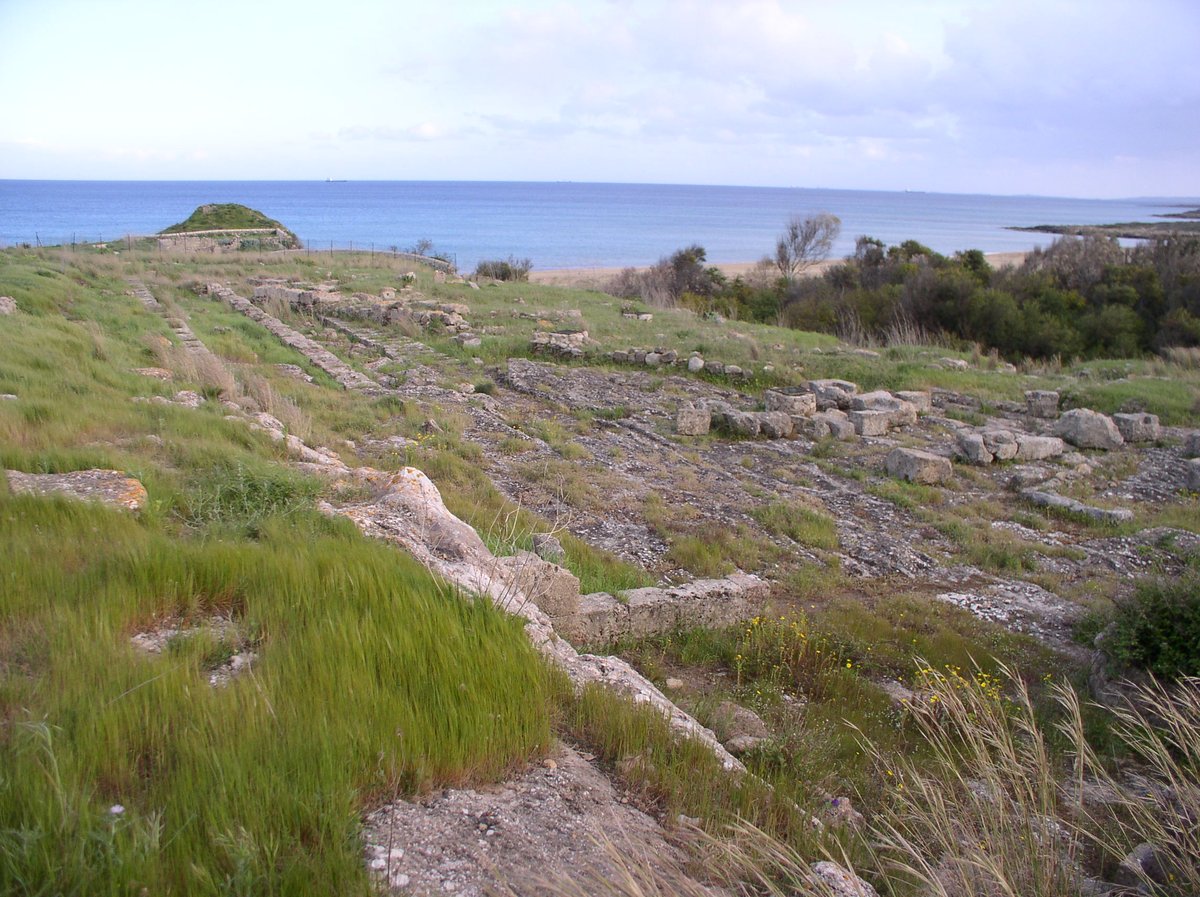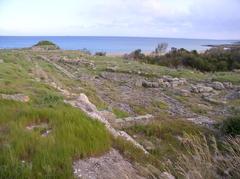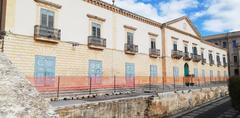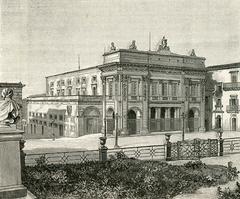
Helorus Visiting Hours, Tickets, and Historical Sites Guide in Noto, Italy
Date: 14/06/2025
Introduction
Nestled on Sicily’s southeastern coast near the UNESCO-listed town of Noto, the ancient city of Helorus (also known as Eloro) is a remarkable archaeological site offering a vivid journey through the layered history of Magna Graecia. Established as a Greek colony under Syracuse in the 7th century BCE, Helorus played a pivotal role in regional trade and defense. Today, its evocative ruins—including city walls, a Hellenistic theater, sacred sanctuaries, and Roman-Byzantine remains—lie within the stunning Vendicari Nature Reserve, blending cultural heritage with natural beauty.
This detailed guide provides essential information for planning your visit: up-to-date Helorus visiting hours, ticket prices, accessibility tips, and advice for maximizing your experience. You’ll also discover how to integrate Helorus into a broader itinerary including Noto’s Baroque wonders, the pristine beaches of Vendicari, and other Southeast Sicily historical sites. Whether you’re a dedicated history buff or a traveler seeking authentic Sicilian experiences, Helorus is a compelling destination beyond the island’s more frequented landmarks.
For further details and the latest updates, consult resources such as Scent of Sicily, Sandee, and Frommer’s Southeast Sicily Guide.
Table of Contents
- Introduction
- Historical Overview of Helorus (Eloro)
- Visiting Helorus: Practical Information
- Nearby Attractions
- Frequently Asked Questions (FAQ)
- Visual Resources
- Conclusion and Visitor Tips
- References
Historical Overview of Helorus (Eloro)
Foundation and Strategic Role
Helorus was established as a colony of Syracuse in the 7th century BCE, strategically positioned at the mouth of the Heloros (modern Tellaro) River. It served as a critical outpost for controlling trade and military movements along Sicily’s southeastern coast, especially during periods of conflict such as the Peloponnesian War. Ancient writers, including Thucydides, highlighted its military significance and frequent involvement in regional power struggles (Sandee).
Archaeological Highlights
Today’s visitor can explore:
- Imposing City Walls and Gates: Built from large limestone blocks, the fortifications (notably the Porta Siracusana and Porta Marina) showcase advanced Greek defensive architecture.
- Hellenistic Theater and Residential Areas: The remnants of a theater with panoramic sea views reflect Helorus’s vibrant civic life. Paved streets and house foundations offer insights into daily existence.
- Sacred Sanctuaries: Excavations have revealed a sanctuary dedicated to Demeter and Kore, with votive offerings illustrating the city’s religious devotion.
- Roman and Byzantine Remains: Later periods saw the addition of baths, road networks, and burial sites, demonstrating Helorus’s adaptation through successive civilizations (Frommer’s Southeast Sicily Guide).
Later History and Decline
Helorus continued to be inhabited through the Roman and Byzantine eras before being abandoned in the early Middle Ages, likely due to environmental and economic changes and the rise of new centers such as Noto.
Visiting Helorus: Practical Information
Visiting Hours and Tickets
- Opening Hours:
- April–October: 9:00 AM to 7:00 PM
- November–March: 9:00 AM to 5:00 PM
Last entry is 30–60 minutes before closing. Hours may vary due to conservation work or special events—always check the official Noto municipal website before your visit.
- Tickets:
- Standard admission is typically €4–€6 for adults.
- EU citizens aged 18–25 may receive reduced rates; children under 18 often enter free.
- Tickets can be purchased at the entrance; some combined tickets with other sites or the Vendicari Reserve may be available.
Accessibility
The site features uneven terrain and some steep or unpaved paths. While main routes are marked, full accessibility is limited. Visitors with mobility challenges should inquire locally for up-to-date information and possible assistance. Sturdy footwear and sun protection are strongly recommended.
Guided Tours and Special Events
Local agencies offer guided tours in Italian, and sometimes English, providing rich historical context. Tours may also include nearby sites such as the Vendicari Reserve or Baroque Noto. Occasionally, archaeological workshops and cultural events take place onsite (Scent of Sicily).
Travel Tips
- Best Time to Visit: Spring and autumn offer mild weather and manageable visitor numbers.
- What to Bring: Water, snacks, sun protection, and a camera for the site’s scenic vistas.
- Facilities: Restrooms and parking are available at the entrance, but there are no food vendors on site.
- Nearby Dining: For meals, head to Lido di Noto or Noto itself.
Nearby Attractions
- Noto (8 km north): Famed for its Baroque architecture, UNESCO status, and vibrant city center (Tourist Secrets).
- Vendicari Nature Reserve: Adjacent to Helorus, offering beaches (Eloro and Calamosche), birdwatching, and scenic trails (Trips & Leisure).
- Cittadella dei Maccari: A Byzantine fortress within the reserve, highlighting the region’s historical depth.
- Other Sites: Akrai (Greek ruins), Villa Romana del Tellaro (mosaics), and towns like Modica and Ragusa.
Frequently Asked Questions (FAQ)
Q: What are the Helorus visiting hours?
A: Typically 9:00 AM–7:00 PM (April–October) and 9:00 AM–5:00 PM (November–March). Check official sources before your visit.
Q: How much do Helorus tickets cost?
A: Standard admission is €4–€6, with reductions for youth and free entry for children.
Q: Is the site accessible for visitors with limited mobility?
A: Partial accessibility is available, but the terrain can be challenging.
Q: Are guided tours available?
A: Yes, bookable onsite or through local agencies.
Q: Can I buy food and drinks at Helorus?
A: No, bring your own or visit Noto/Lido di Noto for refreshments.
Q: Can I take photographs?
A: Absolutely—sunrise and sunset hours are particularly photogenic.
Visual Resources
Imposing limestone city walls at Helorus.
Golden hour lights up the ruins of Helorus—ideal for photography.
Conclusion and Visitor Tips
Helorus (Eloro) offers a unique blend of ancient heritage and natural beauty, making it an essential stop for any traveler in Southeast Sicily. Its archaeological remains—spanning Greek, Roman, and Byzantine eras—tell the story of a city central to the island’s history, while its coastal setting provides a serene backdrop for exploration.
To maximize your experience:
- Visit during spring or autumn for the best weather.
- Pair your Helorus excursion with Noto’s Baroque marvels and the beaches of Vendicari.
- Prepare for limited amenities onsite by bringing water and snacks.
- Consult official sources for up-to-date Helorus visiting hours and ticket prices.
- Consider downloading specialized apps like Audiala for self-guided tours and offline maps.
Embark on your Sicilian adventure and experience the timeless allure of Helorus—where history, landscape, and culture converge.
References and Further Reading
- Scent of Sicily
- Sandee
- Frommer’s Southeast Sicily Guide
- Official Syracuse Archaeological Park Opening Times
- Comune di Noto – Official Tourism
- Vendicari Nature Reserve
- Traveling Season – Noto Tips
- Tourist Secrets: Guide to Noto
- Rachel IRL: Things to Do in Noto




